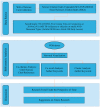Exploring the research landscape of COVID-19-induced olfactory dysfunction: A bibliometric study
- PMID: 37034158
- PMCID: PMC10079987
- DOI: 10.3389/fnins.2023.1164901
Exploring the research landscape of COVID-19-induced olfactory dysfunction: A bibliometric study
Abstract
Since the outbreak of COVID-19, olfactory dysfunction (OD) has become an important and persistent legacy problem that seriously affects the quality of life. The purpose of this paper is to quantitatively analyze and visualize the current research status and development trend of COVID-19 related OD by using VOSviewer software. Based on the Web of Science database, a total of 1,592 relevant documents were retrieved in January 2023, with publication time spanning from 2020 to 2023. The bibliometric analysis revealed that the most influential research results in the field of COVID-19 related OD were concentrated in journals of related disciplines such as otorhinolaryngology, medicine, general and internal, virology, neurosciences, etc. The knowledge base of the research is mainly formed in two fields: COVID-19 clinical research and OD specialized research. The research hotspots are mainly concentrated in six directions: COVID-19, long COVID, smell, anosmia, OD, and recovery. Based on the results of the bibliometric analysis, the temporal trends of COVID-19 related OD studies were visually revealed, and relevant suggestions for future research were proposed.
Keywords: COVID-19 pandemic; cluster analysis; co-citation analysis; co-word analysis; long COVID; olfactory dysfunction.
Copyright © 2023 Yang, Ma, Bi and Tang.
Conflict of interest statement
The authors declare that the research was conducted in the absence of any commercial or financial relationships that could be construed as a potential conflict of interest.
Figures
Similar articles
-
Olfactory and Gustatory Dysfunction in COVID-19: A Global Bibliometric and Visualized Analysis.Ann Otol Rhinol Laryngol. 2023 Feb;132(2):164-172. doi: 10.1177/00034894221082735. Epub 2022 Mar 3. Ann Otol Rhinol Laryngol. 2023. PMID: 35240864 Free PMC article.
-
Knowledge Mapping of Olfactory Dysfunction: A Bibliometric Study.Front Syst Neurosci. 2022 Jun 13;16:904982. doi: 10.3389/fnsys.2022.904982. eCollection 2022. Front Syst Neurosci. 2022. PMID: 35770245 Free PMC article.
-
Olfactory-related Quality of Life Adjustments in Smell Loss during the Coronavirus-19 Pandemic.Am J Rhinol Allergy. 2022 Mar;36(2):253-260. doi: 10.1177/19458924211053118. Epub 2021 Oct 27. Am J Rhinol Allergy. 2022. PMID: 34704454
-
Publication trends of research on COVID-19 and host immune response: A bibliometric analysis.Front Public Health. 2022 Aug 8;10:939053. doi: 10.3389/fpubh.2022.939053. eCollection 2022. Front Public Health. 2022. PMID: 36003630 Free PMC article. Review.
-
Research Hotspots and Trends of Peripheral Nerve Injuries Based on Web of Science From 2017 to 2021: A Bibliometric Analysis.Front Neurol. 2022 May 20;13:872261. doi: 10.3389/fneur.2022.872261. eCollection 2022. Front Neurol. 2022. PMID: 35669875 Free PMC article.
Cited by
-
Platelet-Rich Plasma (PRP) in the Treatment of Long COVID Olfactory Disorders: A Comprehensive Review.Biomedicines. 2024 Apr 5;12(4):808. doi: 10.3390/biomedicines12040808. Biomedicines. 2024. PMID: 38672163 Free PMC article. Review.
-
Insight into NeuroCOVID: neurofilament light chain (NfL) as a biomarker in post-COVID-19 patients with olfactory dysfunctions.J Neurol. 2025 Jul 1;272(7):484. doi: 10.1007/s00415-025-13222-w. J Neurol. 2025. PMID: 40591023 Free PMC article.
-
Long COVID Research, 2020-2024: A PubMed-Based Bibliometric Analysis.Healthcare (Basel). 2025 Feb 1;13(3):298. doi: 10.3390/healthcare13030298. Healthcare (Basel). 2025. PMID: 39942487 Free PMC article. Review.
-
Global landscape of COVID-19 research: a visualization analysis of randomized clinical trials.Clin Exp Med. 2024 Jan 22;24(1):14. doi: 10.1007/s10238-023-01254-3. Clin Exp Med. 2024. PMID: 38252392 Free PMC article.
-
Validity and reliability of the Questionnaire of Olfactory Disorders for Italian-speaking patients with olfactory dysfunction.Acta Otorhinolaryngol Ital. 2024 Feb;44(1):42-51. doi: 10.14639/0392-100X-N2736. Acta Otorhinolaryngol Ital. 2024. PMID: 38420720 Free PMC article.
References
Publication types
LinkOut - more resources
Full Text Sources






